Evaluating Financial Innovations in Nigerian Banks
VerifiedAdded on 2020/04/29
|52
|14126
|183
AI Summary
The assignment is a comprehensive analysis of multiple studies examining technological innovations within the banking sector across Sub-Saharan Africa, focusing primarily on Nigeria but including insights from Kenya and Turkey as well. The research evaluates electronic banking services and mobile banking's influence on financial performance among commercial banks, highlighting differences between traditional and Islamic banking models in Turkey. Additionally, it investigates how these advancements have affected SME financing options and customer satisfaction with bank services in Nigeria. With a spotlight on the period post-banking sector consolidation (2005-2012), the assignment underscores economic openness and inflation's roles in shaping profitability. Key findings also touch upon the effects of cashless policies and remittance impacts on banking breadth, providing an encompassing view of the evolving landscape in African financial services.
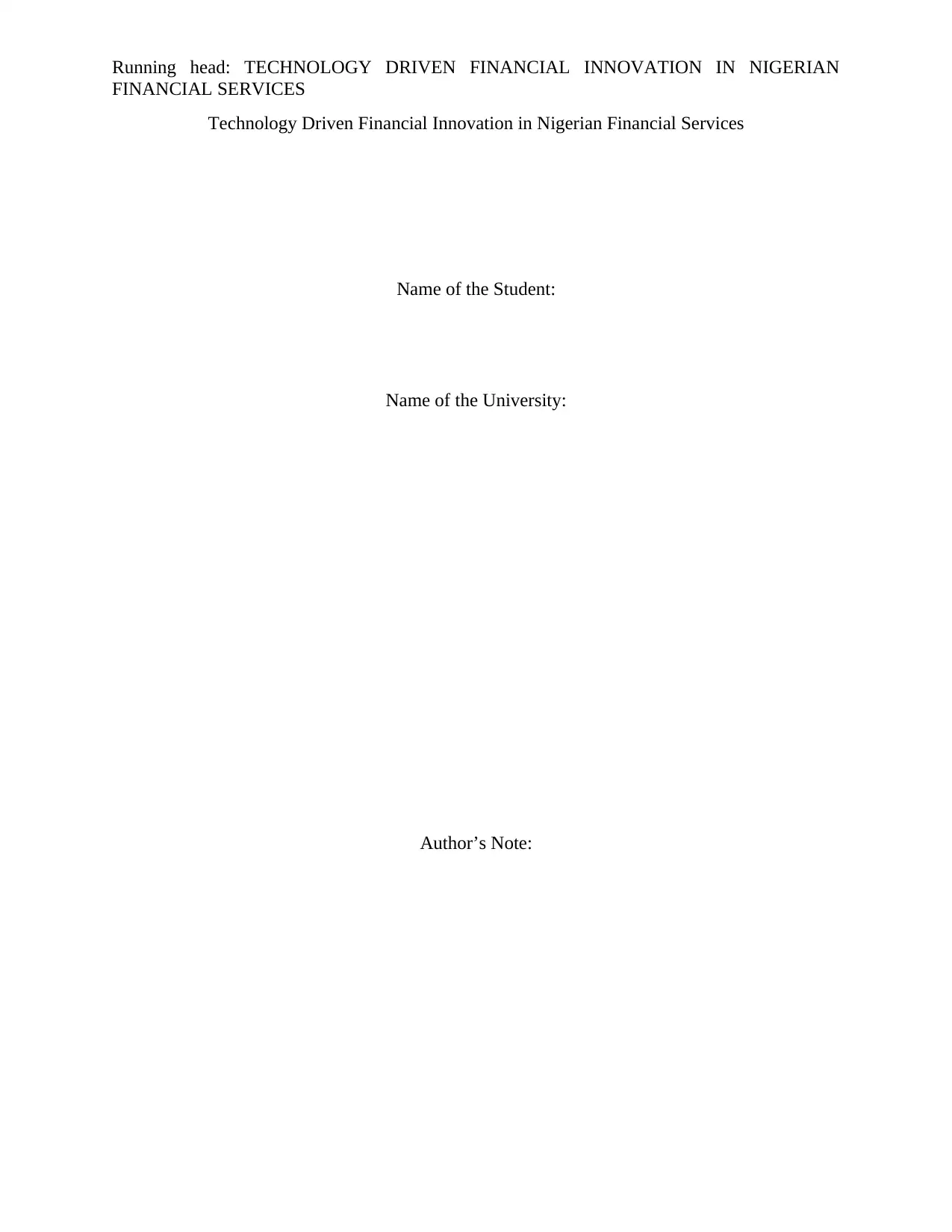
Running head: TECHNOLOGY DRIVEN FINANCIAL INNOVATION IN NIGERIAN
FINANCIAL SERVICES
Technology Driven Financial Innovation in Nigerian Financial Services
Name of the Student:
Name of the University:
Author’s Note:
FINANCIAL SERVICES
Technology Driven Financial Innovation in Nigerian Financial Services
Name of the Student:
Name of the University:
Author’s Note:
Paraphrase This Document
Need a fresh take? Get an instant paraphrase of this document with our AI Paraphraser

1
TECHNOLOGY DRIVEN FINANCIAL INNOVATION IN NIGERIAN FINANCIAL
SERVICES
Declaration
TECHNOLOGY DRIVEN FINANCIAL INNOVATION IN NIGERIAN FINANCIAL
SERVICES
Declaration

2
TECHNOLOGY DRIVEN FINANCIAL INNOVATION IN NIGERIAN FINANCIAL
SERVICES
Acknowledgement
TECHNOLOGY DRIVEN FINANCIAL INNOVATION IN NIGERIAN FINANCIAL
SERVICES
Acknowledgement
⊘ This is a preview!⊘
Do you want full access?
Subscribe today to unlock all pages.

Trusted by 1+ million students worldwide

3
TECHNOLOGY DRIVEN FINANCIAL INNOVATION IN NIGERIAN FINANCIAL
SERVICES
Abstract
TECHNOLOGY DRIVEN FINANCIAL INNOVATION IN NIGERIAN FINANCIAL
SERVICES
Abstract
Paraphrase This Document
Need a fresh take? Get an instant paraphrase of this document with our AI Paraphraser
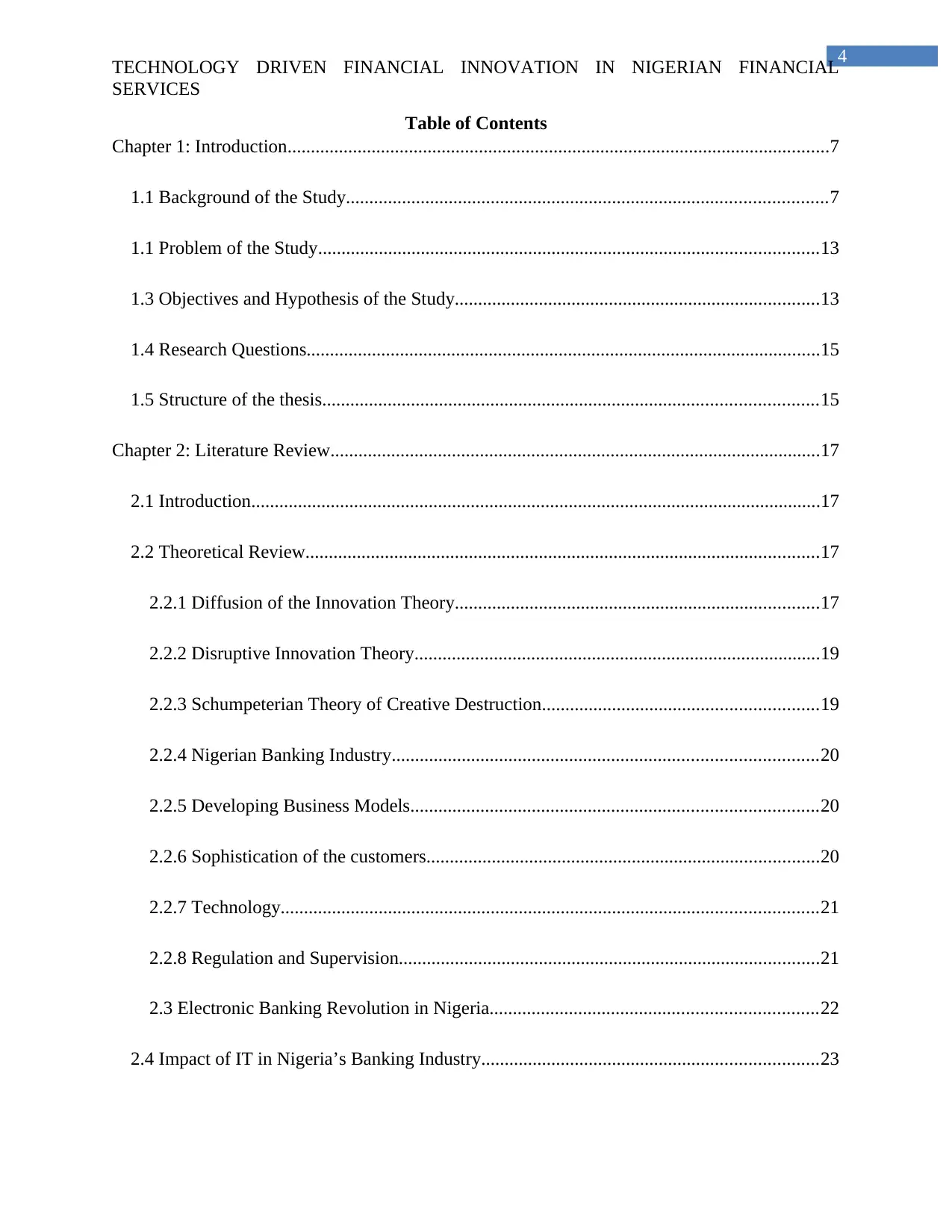
4
TECHNOLOGY DRIVEN FINANCIAL INNOVATION IN NIGERIAN FINANCIAL
SERVICES
Table of Contents
Chapter 1: Introduction....................................................................................................................7
1.1 Background of the Study.......................................................................................................7
1.1 Problem of the Study...........................................................................................................13
1.3 Objectives and Hypothesis of the Study..............................................................................13
1.4 Research Questions..............................................................................................................15
1.5 Structure of the thesis..........................................................................................................15
Chapter 2: Literature Review.........................................................................................................17
2.1 Introduction..........................................................................................................................17
2.2 Theoretical Review..............................................................................................................17
2.2.1 Diffusion of the Innovation Theory..............................................................................17
2.2.2 Disruptive Innovation Theory.......................................................................................19
2.2.3 Schumpeterian Theory of Creative Destruction...........................................................19
2.2.4 Nigerian Banking Industry...........................................................................................20
2.2.5 Developing Business Models.......................................................................................20
2.2.6 Sophistication of the customers....................................................................................20
2.2.7 Technology...................................................................................................................21
2.2.8 Regulation and Supervision..........................................................................................21
2.3 Electronic Banking Revolution in Nigeria......................................................................22
2.4 Impact of IT in Nigeria’s Banking Industry........................................................................23
TECHNOLOGY DRIVEN FINANCIAL INNOVATION IN NIGERIAN FINANCIAL
SERVICES
Table of Contents
Chapter 1: Introduction....................................................................................................................7
1.1 Background of the Study.......................................................................................................7
1.1 Problem of the Study...........................................................................................................13
1.3 Objectives and Hypothesis of the Study..............................................................................13
1.4 Research Questions..............................................................................................................15
1.5 Structure of the thesis..........................................................................................................15
Chapter 2: Literature Review.........................................................................................................17
2.1 Introduction..........................................................................................................................17
2.2 Theoretical Review..............................................................................................................17
2.2.1 Diffusion of the Innovation Theory..............................................................................17
2.2.2 Disruptive Innovation Theory.......................................................................................19
2.2.3 Schumpeterian Theory of Creative Destruction...........................................................19
2.2.4 Nigerian Banking Industry...........................................................................................20
2.2.5 Developing Business Models.......................................................................................20
2.2.6 Sophistication of the customers....................................................................................20
2.2.7 Technology...................................................................................................................21
2.2.8 Regulation and Supervision..........................................................................................21
2.3 Electronic Banking Revolution in Nigeria......................................................................22
2.4 Impact of IT in Nigeria’s Banking Industry........................................................................23
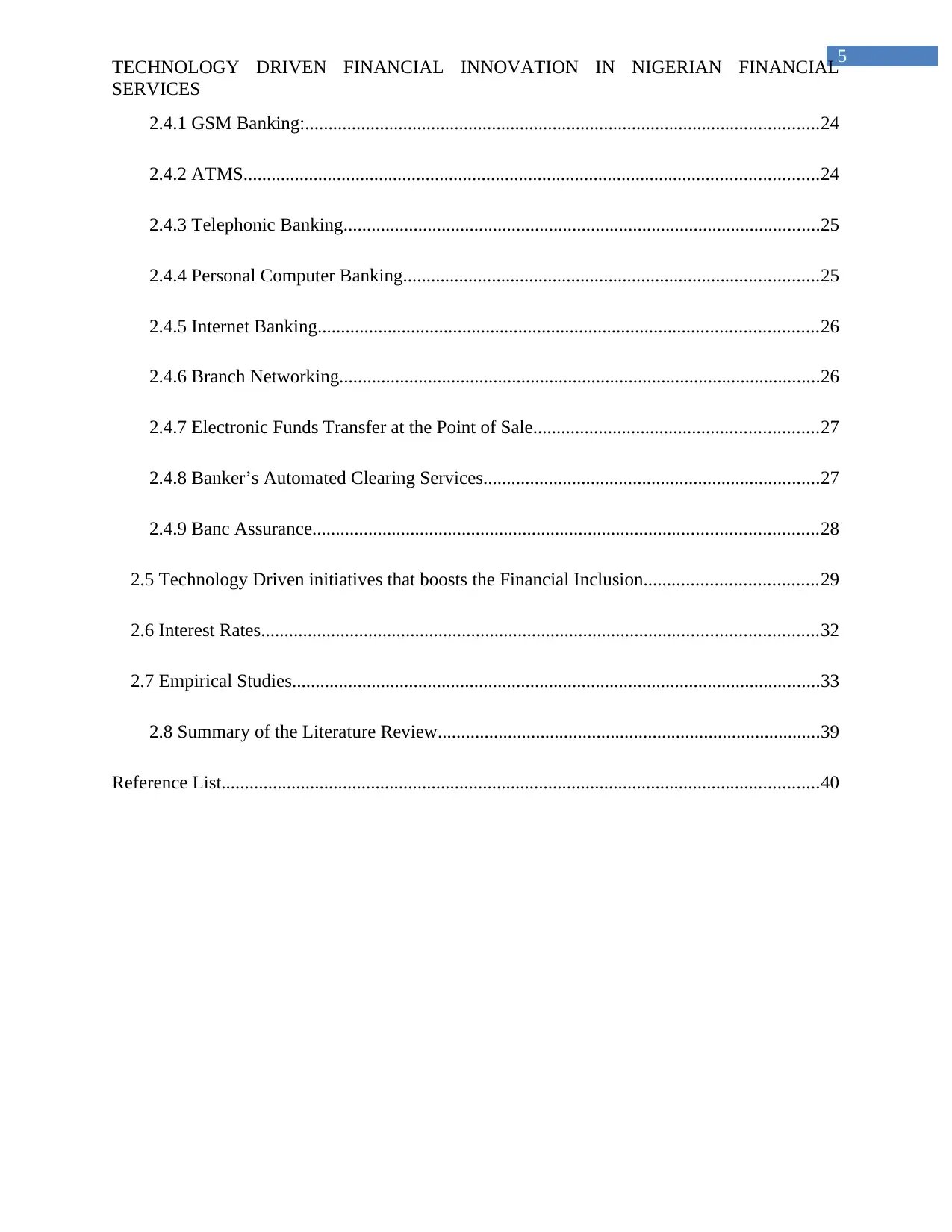
5
TECHNOLOGY DRIVEN FINANCIAL INNOVATION IN NIGERIAN FINANCIAL
SERVICES
2.4.1 GSM Banking:..............................................................................................................24
2.4.2 ATMS...........................................................................................................................24
2.4.3 Telephonic Banking......................................................................................................25
2.4.4 Personal Computer Banking.........................................................................................25
2.4.5 Internet Banking...........................................................................................................26
2.4.6 Branch Networking.......................................................................................................26
2.4.7 Electronic Funds Transfer at the Point of Sale.............................................................27
2.4.8 Banker’s Automated Clearing Services........................................................................27
2.4.9 Banc Assurance............................................................................................................28
2.5 Technology Driven initiatives that boosts the Financial Inclusion.....................................29
2.6 Interest Rates.......................................................................................................................32
2.7 Empirical Studies.................................................................................................................33
2.8 Summary of the Literature Review..................................................................................39
Reference List................................................................................................................................40
TECHNOLOGY DRIVEN FINANCIAL INNOVATION IN NIGERIAN FINANCIAL
SERVICES
2.4.1 GSM Banking:..............................................................................................................24
2.4.2 ATMS...........................................................................................................................24
2.4.3 Telephonic Banking......................................................................................................25
2.4.4 Personal Computer Banking.........................................................................................25
2.4.5 Internet Banking...........................................................................................................26
2.4.6 Branch Networking.......................................................................................................26
2.4.7 Electronic Funds Transfer at the Point of Sale.............................................................27
2.4.8 Banker’s Automated Clearing Services........................................................................27
2.4.9 Banc Assurance............................................................................................................28
2.5 Technology Driven initiatives that boosts the Financial Inclusion.....................................29
2.6 Interest Rates.......................................................................................................................32
2.7 Empirical Studies.................................................................................................................33
2.8 Summary of the Literature Review..................................................................................39
Reference List................................................................................................................................40
⊘ This is a preview!⊘
Do you want full access?
Subscribe today to unlock all pages.

Trusted by 1+ million students worldwide

6
TECHNOLOGY DRIVEN FINANCIAL INNOVATION IN NIGERIAN FINANCIAL
SERVICES
TECHNOLOGY DRIVEN FINANCIAL INNOVATION IN NIGERIAN FINANCIAL
SERVICES
Paraphrase This Document
Need a fresh take? Get an instant paraphrase of this document with our AI Paraphraser
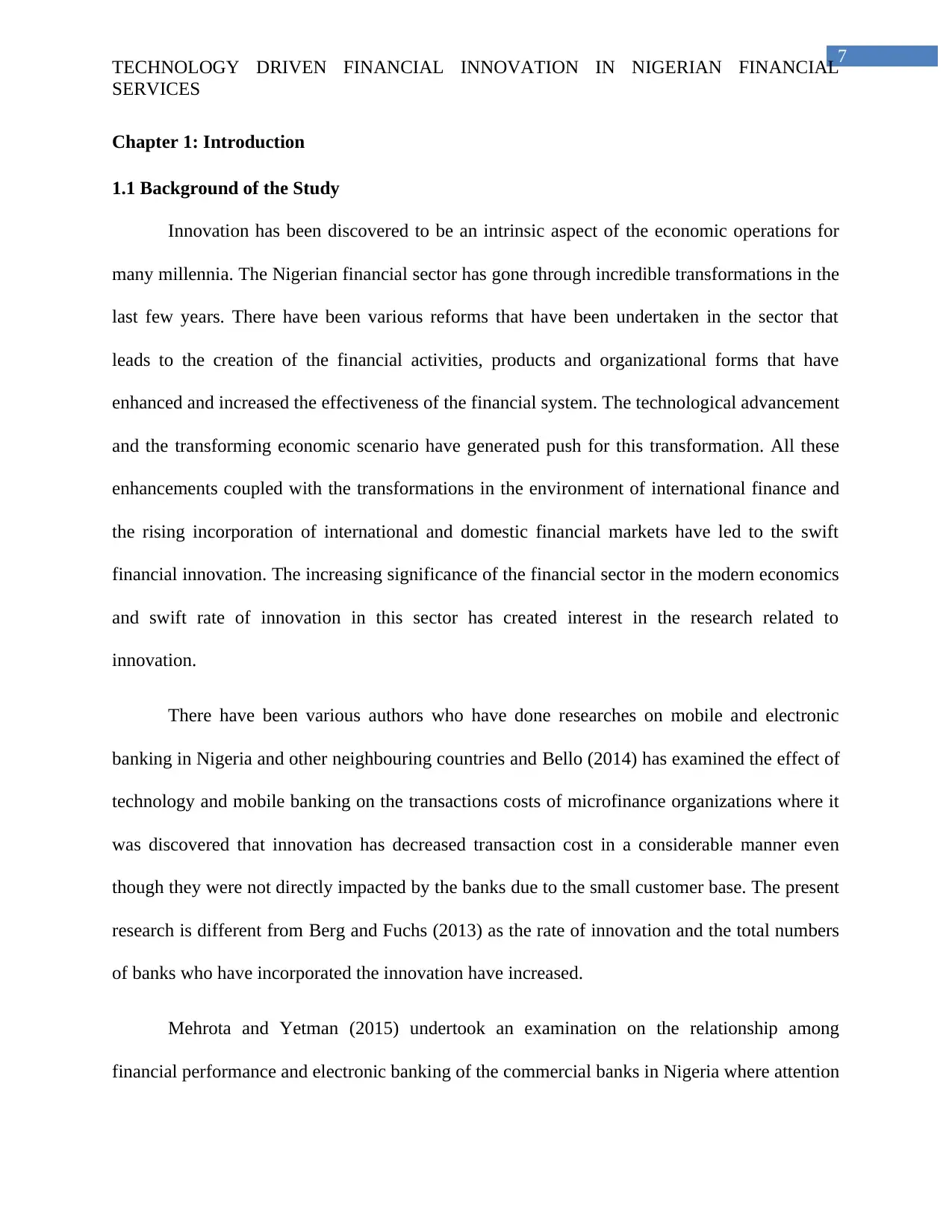
7
TECHNOLOGY DRIVEN FINANCIAL INNOVATION IN NIGERIAN FINANCIAL
SERVICES
Chapter 1: Introduction
1.1 Background of the Study
Innovation has been discovered to be an intrinsic aspect of the economic operations for
many millennia. The Nigerian financial sector has gone through incredible transformations in the
last few years. There have been various reforms that have been undertaken in the sector that
leads to the creation of the financial activities, products and organizational forms that have
enhanced and increased the effectiveness of the financial system. The technological advancement
and the transforming economic scenario have generated push for this transformation. All these
enhancements coupled with the transformations in the environment of international finance and
the rising incorporation of international and domestic financial markets have led to the swift
financial innovation. The increasing significance of the financial sector in the modern economics
and swift rate of innovation in this sector has created interest in the research related to
innovation.
There have been various authors who have done researches on mobile and electronic
banking in Nigeria and other neighbouring countries and Bello (2014) has examined the effect of
technology and mobile banking on the transactions costs of microfinance organizations where it
was discovered that innovation has decreased transaction cost in a considerable manner even
though they were not directly impacted by the banks due to the small customer base. The present
research is different from Berg and Fuchs (2013) as the rate of innovation and the total numbers
of banks who have incorporated the innovation have increased.
Mehrota and Yetman (2015) undertook an examination on the relationship among
financial performance and electronic banking of the commercial banks in Nigeria where attention
TECHNOLOGY DRIVEN FINANCIAL INNOVATION IN NIGERIAN FINANCIAL
SERVICES
Chapter 1: Introduction
1.1 Background of the Study
Innovation has been discovered to be an intrinsic aspect of the economic operations for
many millennia. The Nigerian financial sector has gone through incredible transformations in the
last few years. There have been various reforms that have been undertaken in the sector that
leads to the creation of the financial activities, products and organizational forms that have
enhanced and increased the effectiveness of the financial system. The technological advancement
and the transforming economic scenario have generated push for this transformation. All these
enhancements coupled with the transformations in the environment of international finance and
the rising incorporation of international and domestic financial markets have led to the swift
financial innovation. The increasing significance of the financial sector in the modern economics
and swift rate of innovation in this sector has created interest in the research related to
innovation.
There have been various authors who have done researches on mobile and electronic
banking in Nigeria and other neighbouring countries and Bello (2014) has examined the effect of
technology and mobile banking on the transactions costs of microfinance organizations where it
was discovered that innovation has decreased transaction cost in a considerable manner even
though they were not directly impacted by the banks due to the small customer base. The present
research is different from Berg and Fuchs (2013) as the rate of innovation and the total numbers
of banks who have incorporated the innovation have increased.
Mehrota and Yetman (2015) undertook an examination on the relationship among
financial performance and electronic banking of the commercial banks in Nigeria where attention
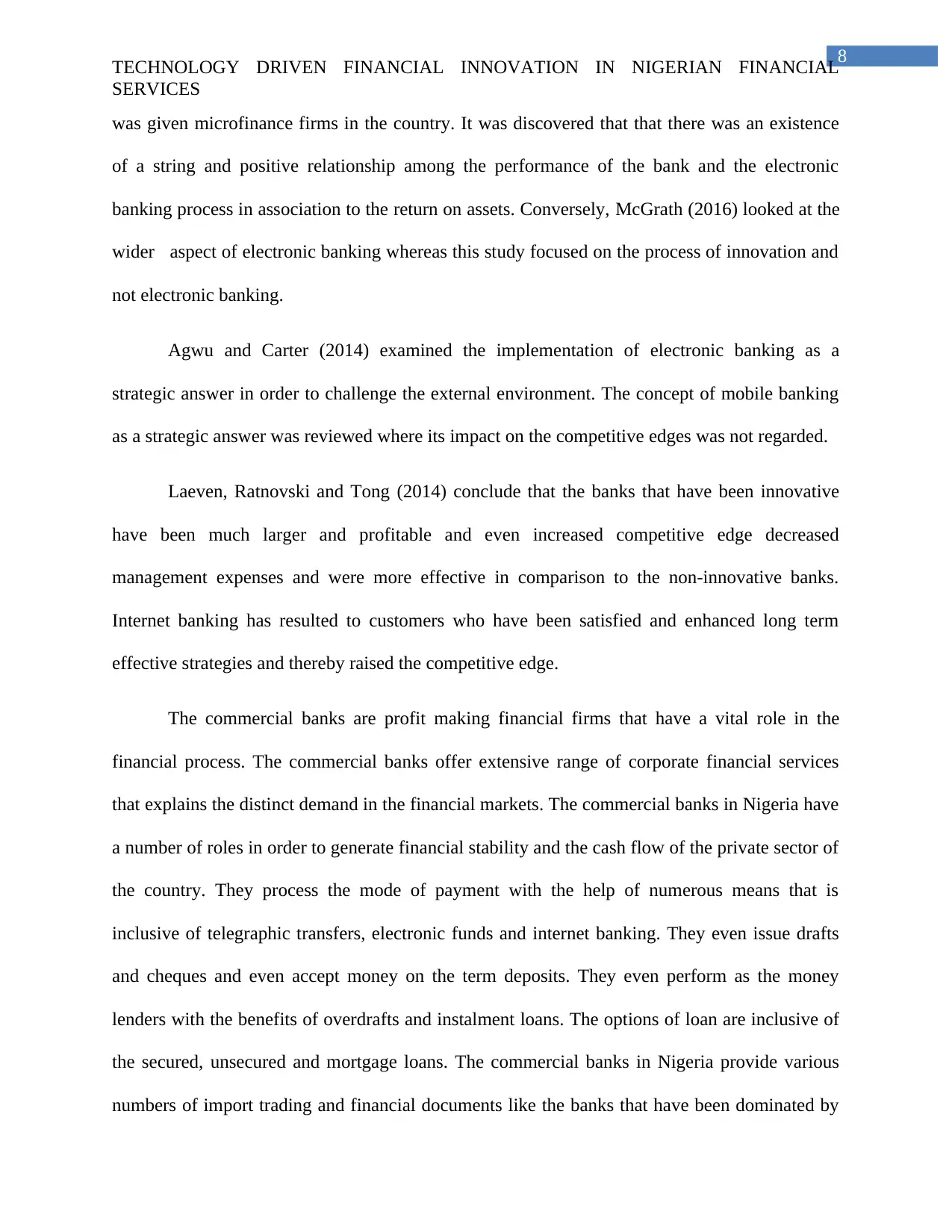
8
TECHNOLOGY DRIVEN FINANCIAL INNOVATION IN NIGERIAN FINANCIAL
SERVICES
was given microfinance firms in the country. It was discovered that that there was an existence
of a string and positive relationship among the performance of the bank and the electronic
banking process in association to the return on assets. Conversely, McGrath (2016) looked at the
wider aspect of electronic banking whereas this study focused on the process of innovation and
not electronic banking.
Agwu and Carter (2014) examined the implementation of electronic banking as a
strategic answer in order to challenge the external environment. The concept of mobile banking
as a strategic answer was reviewed where its impact on the competitive edges was not regarded.
Laeven, Ratnovski and Tong (2014) conclude that the banks that have been innovative
have been much larger and profitable and even increased competitive edge decreased
management expenses and were more effective in comparison to the non-innovative banks.
Internet banking has resulted to customers who have been satisfied and enhanced long term
effective strategies and thereby raised the competitive edge.
The commercial banks are profit making financial firms that have a vital role in the
financial process. The commercial banks offer extensive range of corporate financial services
that explains the distinct demand in the financial markets. The commercial banks in Nigeria have
a number of roles in order to generate financial stability and the cash flow of the private sector of
the country. They process the mode of payment with the help of numerous means that is
inclusive of telegraphic transfers, electronic funds and internet banking. They even issue drafts
and cheques and even accept money on the term deposits. They even perform as the money
lenders with the benefits of overdrafts and instalment loans. The options of loan are inclusive of
the secured, unsecured and mortgage loans. The commercial banks in Nigeria provide various
numbers of import trading and financial documents like the banks that have been dominated by
TECHNOLOGY DRIVEN FINANCIAL INNOVATION IN NIGERIAN FINANCIAL
SERVICES
was given microfinance firms in the country. It was discovered that that there was an existence
of a string and positive relationship among the performance of the bank and the electronic
banking process in association to the return on assets. Conversely, McGrath (2016) looked at the
wider aspect of electronic banking whereas this study focused on the process of innovation and
not electronic banking.
Agwu and Carter (2014) examined the implementation of electronic banking as a
strategic answer in order to challenge the external environment. The concept of mobile banking
as a strategic answer was reviewed where its impact on the competitive edges was not regarded.
Laeven, Ratnovski and Tong (2014) conclude that the banks that have been innovative
have been much larger and profitable and even increased competitive edge decreased
management expenses and were more effective in comparison to the non-innovative banks.
Internet banking has resulted to customers who have been satisfied and enhanced long term
effective strategies and thereby raised the competitive edge.
The commercial banks are profit making financial firms that have a vital role in the
financial process. The commercial banks offer extensive range of corporate financial services
that explains the distinct demand in the financial markets. The commercial banks in Nigeria have
a number of roles in order to generate financial stability and the cash flow of the private sector of
the country. They process the mode of payment with the help of numerous means that is
inclusive of telegraphic transfers, electronic funds and internet banking. They even issue drafts
and cheques and even accept money on the term deposits. They even perform as the money
lenders with the benefits of overdrafts and instalment loans. The options of loan are inclusive of
the secured, unsecured and mortgage loans. The commercial banks in Nigeria provide various
numbers of import trading and financial documents like the banks that have been dominated by
⊘ This is a preview!⊘
Do you want full access?
Subscribe today to unlock all pages.

Trusted by 1+ million students worldwide
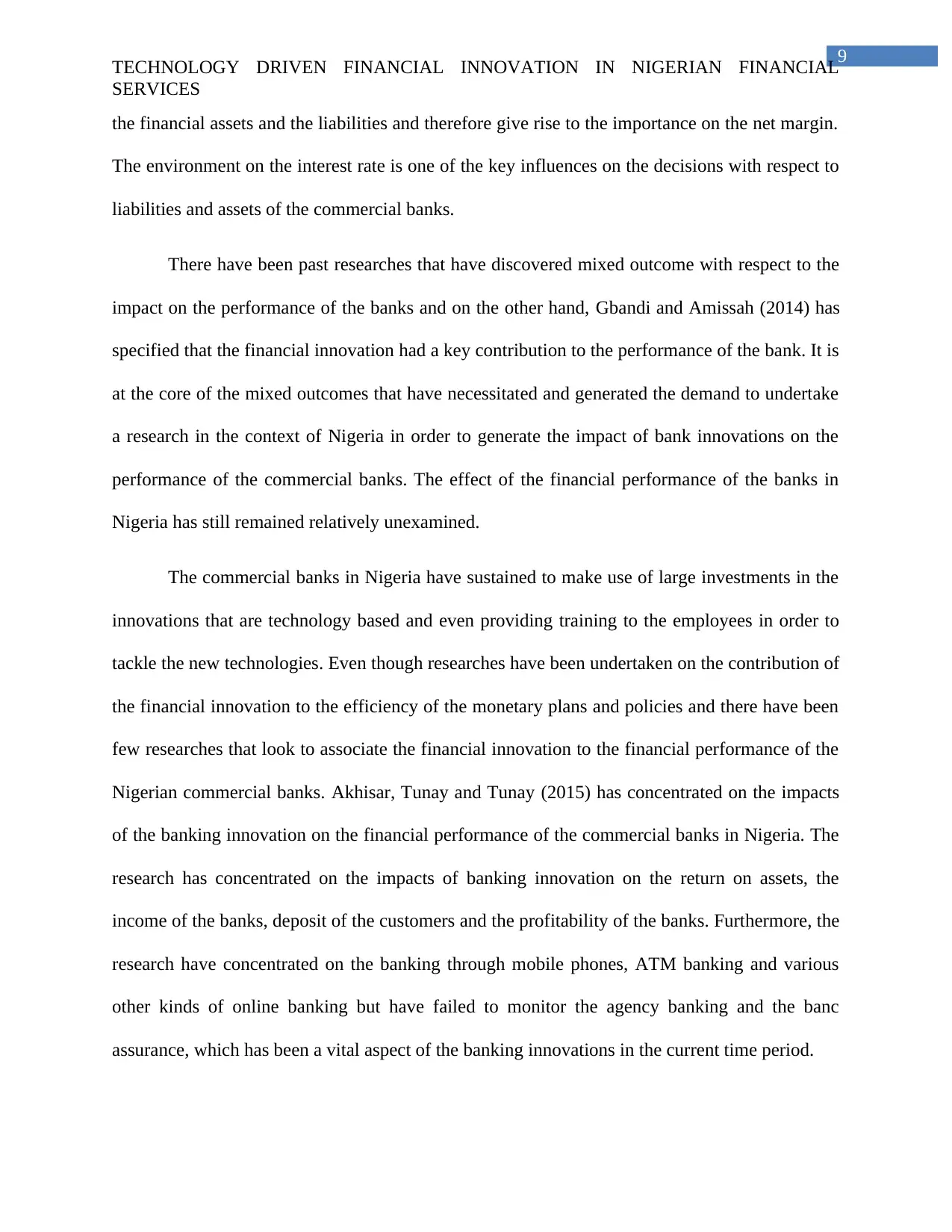
9
TECHNOLOGY DRIVEN FINANCIAL INNOVATION IN NIGERIAN FINANCIAL
SERVICES
the financial assets and the liabilities and therefore give rise to the importance on the net margin.
The environment on the interest rate is one of the key influences on the decisions with respect to
liabilities and assets of the commercial banks.
There have been past researches that have discovered mixed outcome with respect to the
impact on the performance of the banks and on the other hand, Gbandi and Amissah (2014) has
specified that the financial innovation had a key contribution to the performance of the bank. It is
at the core of the mixed outcomes that have necessitated and generated the demand to undertake
a research in the context of Nigeria in order to generate the impact of bank innovations on the
performance of the commercial banks. The effect of the financial performance of the banks in
Nigeria has still remained relatively unexamined.
The commercial banks in Nigeria have sustained to make use of large investments in the
innovations that are technology based and even providing training to the employees in order to
tackle the new technologies. Even though researches have been undertaken on the contribution of
the financial innovation to the efficiency of the monetary plans and policies and there have been
few researches that look to associate the financial innovation to the financial performance of the
Nigerian commercial banks. Akhisar, Tunay and Tunay (2015) has concentrated on the impacts
of the banking innovation on the financial performance of the commercial banks in Nigeria. The
research has concentrated on the impacts of banking innovation on the return on assets, the
income of the banks, deposit of the customers and the profitability of the banks. Furthermore, the
research have concentrated on the banking through mobile phones, ATM banking and various
other kinds of online banking but have failed to monitor the agency banking and the banc
assurance, which has been a vital aspect of the banking innovations in the current time period.
TECHNOLOGY DRIVEN FINANCIAL INNOVATION IN NIGERIAN FINANCIAL
SERVICES
the financial assets and the liabilities and therefore give rise to the importance on the net margin.
The environment on the interest rate is one of the key influences on the decisions with respect to
liabilities and assets of the commercial banks.
There have been past researches that have discovered mixed outcome with respect to the
impact on the performance of the banks and on the other hand, Gbandi and Amissah (2014) has
specified that the financial innovation had a key contribution to the performance of the bank. It is
at the core of the mixed outcomes that have necessitated and generated the demand to undertake
a research in the context of Nigeria in order to generate the impact of bank innovations on the
performance of the commercial banks. The effect of the financial performance of the banks in
Nigeria has still remained relatively unexamined.
The commercial banks in Nigeria have sustained to make use of large investments in the
innovations that are technology based and even providing training to the employees in order to
tackle the new technologies. Even though researches have been undertaken on the contribution of
the financial innovation to the efficiency of the monetary plans and policies and there have been
few researches that look to associate the financial innovation to the financial performance of the
Nigerian commercial banks. Akhisar, Tunay and Tunay (2015) has concentrated on the impacts
of the banking innovation on the financial performance of the commercial banks in Nigeria. The
research has concentrated on the impacts of banking innovation on the return on assets, the
income of the banks, deposit of the customers and the profitability of the banks. Furthermore, the
research have concentrated on the banking through mobile phones, ATM banking and various
other kinds of online banking but have failed to monitor the agency banking and the banc
assurance, which has been a vital aspect of the banking innovations in the current time period.
Paraphrase This Document
Need a fresh take? Get an instant paraphrase of this document with our AI Paraphraser

10
TECHNOLOGY DRIVEN FINANCIAL INNOVATION IN NIGERIAN FINANCIAL
SERVICES
Financial innovation is a significant aspect of study that is associated with effective
banking products and services on the information technology ICT platform and in this manner
improving the financial penetration, financial insight and economic development. The main
obligation of the Central bank of Nigeria has been the development of the financial system of
Nigeria along with controlling, regulating and licensing the banks that operate in the Nigerian
economy. The country is therefore interested in the financial inclusion, financial deepening and
efforts for financial penetration of the banks with the help of the innovative services and
products that act as financial intermediaries. The financial inclusion is specifically explained as
defining the access to formal financial services at a reasonable cost in a transparent and fair mean
(Ilo, Wilson and Nnanyelugo 2014). The financial inclusion simply explains the access to the
financial services and resources for the economic representatives significantly the ones that are
on the lower section of the income ladder at a reasonable cost. The strategies that are associated
with the financial inclusion look to raise the number of individuals with the accounts that are in
the bank and in any other formal financial organizations in their current and savings account. It
even pursues the development of the utilisation of the payment media that are formal in nature
that are inclusive of the payment of the interest, payment through mobile, ATM etc. The strategy
of financial inclusion explains that financial inclusion is attained when the Nigerians have simple
access to the wide range of the formal financial services that satisfy their need at a reasonable
cost.
One of the key focuses of the monetary policy is to manage the cost and the money and
credit availability in the economy. The efficiency of the monetary policy may be overlooked if a
larger section of the population lacks entry to the formal financial framework. The wider the size
of the formal sector the more efficient is the monetary policy will become. The central banks
TECHNOLOGY DRIVEN FINANCIAL INNOVATION IN NIGERIAN FINANCIAL
SERVICES
Financial innovation is a significant aspect of study that is associated with effective
banking products and services on the information technology ICT platform and in this manner
improving the financial penetration, financial insight and economic development. The main
obligation of the Central bank of Nigeria has been the development of the financial system of
Nigeria along with controlling, regulating and licensing the banks that operate in the Nigerian
economy. The country is therefore interested in the financial inclusion, financial deepening and
efforts for financial penetration of the banks with the help of the innovative services and
products that act as financial intermediaries. The financial inclusion is specifically explained as
defining the access to formal financial services at a reasonable cost in a transparent and fair mean
(Ilo, Wilson and Nnanyelugo 2014). The financial inclusion simply explains the access to the
financial services and resources for the economic representatives significantly the ones that are
on the lower section of the income ladder at a reasonable cost. The strategies that are associated
with the financial inclusion look to raise the number of individuals with the accounts that are in
the bank and in any other formal financial organizations in their current and savings account. It
even pursues the development of the utilisation of the payment media that are formal in nature
that are inclusive of the payment of the interest, payment through mobile, ATM etc. The strategy
of financial inclusion explains that financial inclusion is attained when the Nigerians have simple
access to the wide range of the formal financial services that satisfy their need at a reasonable
cost.
One of the key focuses of the monetary policy is to manage the cost and the money and
credit availability in the economy. The efficiency of the monetary policy may be overlooked if a
larger section of the population lacks entry to the formal financial framework. The wider the size
of the formal sector the more efficient is the monetary policy will become. The central banks
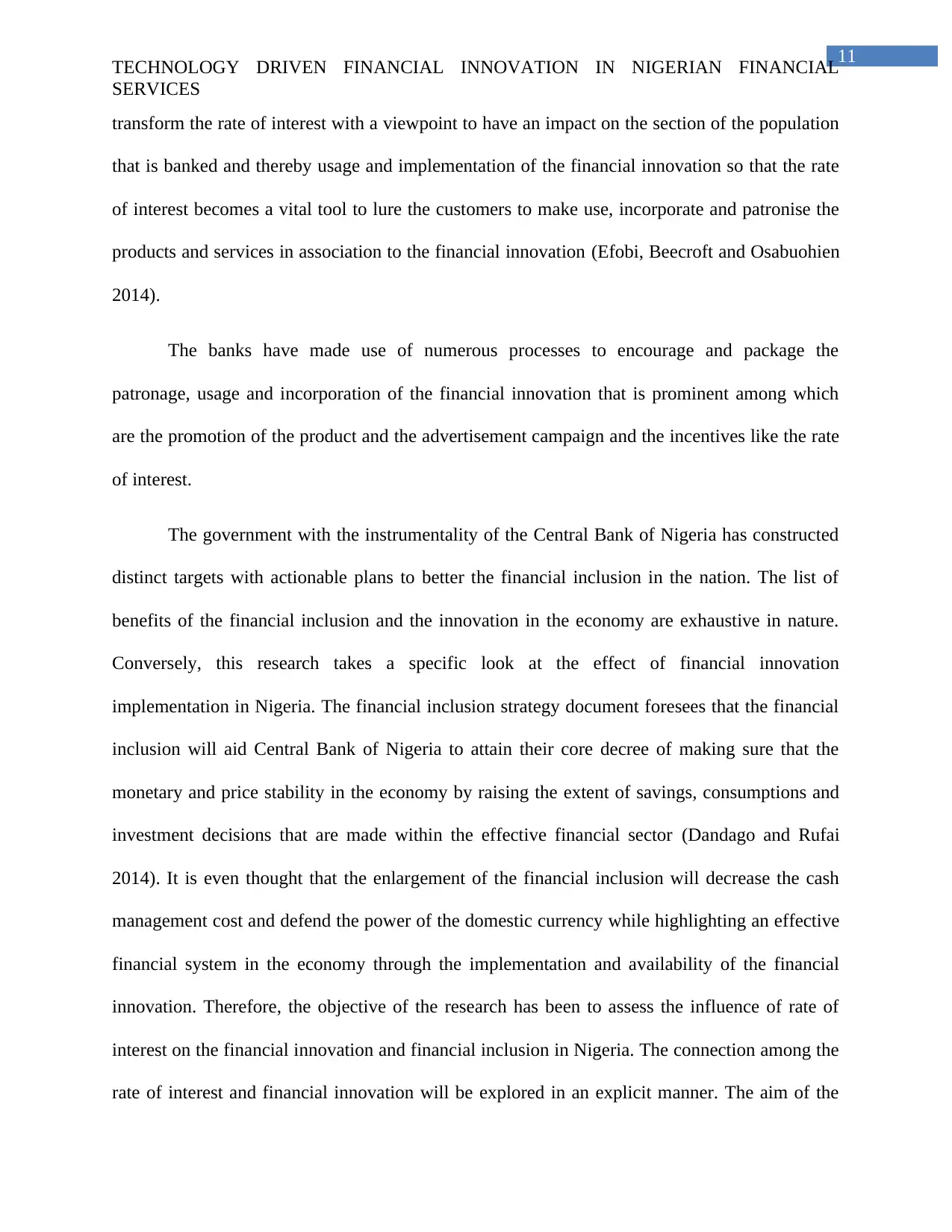
11
TECHNOLOGY DRIVEN FINANCIAL INNOVATION IN NIGERIAN FINANCIAL
SERVICES
transform the rate of interest with a viewpoint to have an impact on the section of the population
that is banked and thereby usage and implementation of the financial innovation so that the rate
of interest becomes a vital tool to lure the customers to make use, incorporate and patronise the
products and services in association to the financial innovation (Efobi, Beecroft and Osabuohien
2014).
The banks have made use of numerous processes to encourage and package the
patronage, usage and incorporation of the financial innovation that is prominent among which
are the promotion of the product and the advertisement campaign and the incentives like the rate
of interest.
The government with the instrumentality of the Central Bank of Nigeria has constructed
distinct targets with actionable plans to better the financial inclusion in the nation. The list of
benefits of the financial inclusion and the innovation in the economy are exhaustive in nature.
Conversely, this research takes a specific look at the effect of financial innovation
implementation in Nigeria. The financial inclusion strategy document foresees that the financial
inclusion will aid Central Bank of Nigeria to attain their core decree of making sure that the
monetary and price stability in the economy by raising the extent of savings, consumptions and
investment decisions that are made within the effective financial sector (Dandago and Rufai
2014). It is even thought that the enlargement of the financial inclusion will decrease the cash
management cost and defend the power of the domestic currency while highlighting an effective
financial system in the economy through the implementation and availability of the financial
innovation. Therefore, the objective of the research has been to assess the influence of rate of
interest on the financial innovation and financial inclusion in Nigeria. The connection among the
rate of interest and financial innovation will be explored in an explicit manner. The aim of the
TECHNOLOGY DRIVEN FINANCIAL INNOVATION IN NIGERIAN FINANCIAL
SERVICES
transform the rate of interest with a viewpoint to have an impact on the section of the population
that is banked and thereby usage and implementation of the financial innovation so that the rate
of interest becomes a vital tool to lure the customers to make use, incorporate and patronise the
products and services in association to the financial innovation (Efobi, Beecroft and Osabuohien
2014).
The banks have made use of numerous processes to encourage and package the
patronage, usage and incorporation of the financial innovation that is prominent among which
are the promotion of the product and the advertisement campaign and the incentives like the rate
of interest.
The government with the instrumentality of the Central Bank of Nigeria has constructed
distinct targets with actionable plans to better the financial inclusion in the nation. The list of
benefits of the financial inclusion and the innovation in the economy are exhaustive in nature.
Conversely, this research takes a specific look at the effect of financial innovation
implementation in Nigeria. The financial inclusion strategy document foresees that the financial
inclusion will aid Central Bank of Nigeria to attain their core decree of making sure that the
monetary and price stability in the economy by raising the extent of savings, consumptions and
investment decisions that are made within the effective financial sector (Dandago and Rufai
2014). It is even thought that the enlargement of the financial inclusion will decrease the cash
management cost and defend the power of the domestic currency while highlighting an effective
financial system in the economy through the implementation and availability of the financial
innovation. Therefore, the objective of the research has been to assess the influence of rate of
interest on the financial innovation and financial inclusion in Nigeria. The connection among the
rate of interest and financial innovation will be explored in an explicit manner. The aim of the
⊘ This is a preview!⊘
Do you want full access?
Subscribe today to unlock all pages.

Trusted by 1+ million students worldwide
1 out of 52
Related Documents
Your All-in-One AI-Powered Toolkit for Academic Success.
+13062052269
info@desklib.com
Available 24*7 on WhatsApp / Email
![[object Object]](/_next/static/media/star-bottom.7253800d.svg)
Unlock your academic potential
Copyright © 2020–2025 A2Z Services. All Rights Reserved. Developed and managed by ZUCOL.





